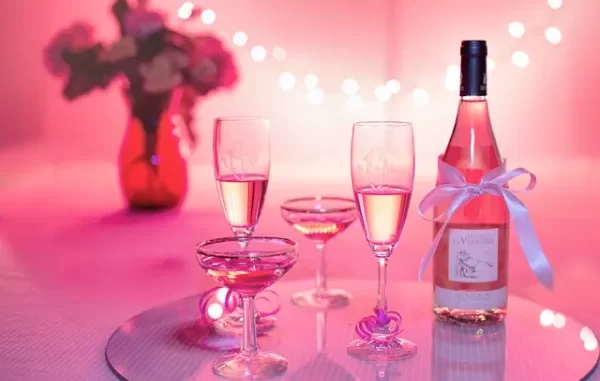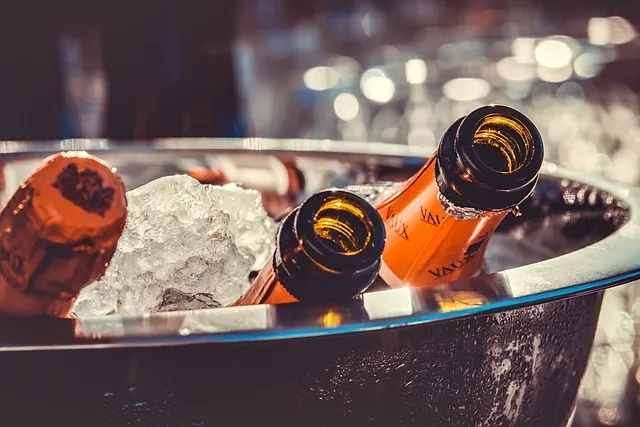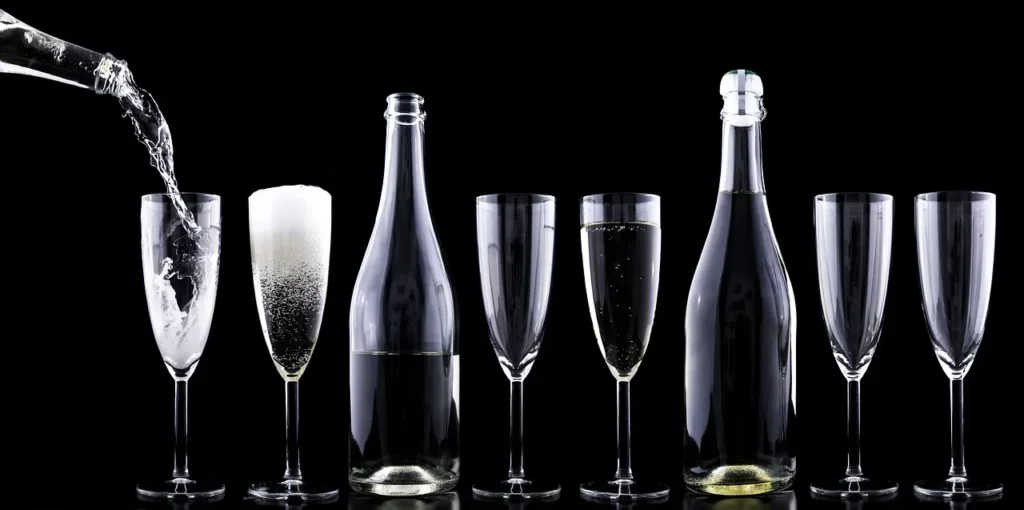
Welcome to the fascinating realm of Champagne! For centuries, this sparkling wine has captured the hearts of many, yet its history and culture remain elusive to most. Our aim is to delve into the intriguing world of Champagne, unraveling its secrets and sharing captivating facts.
Discover the captivating story behind this illustrious beverage, explore its diverse varieties, and delve into the unique traditions that surround it. Whether you’re a seasoned enthusiast or a curious novice, prepare to embark on an exciting journey of discovery through the enchanting world of Champagne!
Uncovering the Fascinating Story Behind Champagne
Champagne has a fascinating history that dates back to the 17th century. It is a sparkling wine produced in the Champagne region of France using a traditional method of secondary fermentation in the bottle. This process is complex and time-consuming.
The credit for developing this method goes to Dom Perignon, a Benedictine monk who was the cellar master at the Benedictine Abbey of Hautvillers. He used the méthode champenoise, which involves fermenting still wines in the bottle to create sparkling wines. Dom Perignon referred to these wines as “drinking stars” and put in a lot of effort to perfect the process.
Champagne’s ascent to becoming the most luxurious sparkling wine is credited to Nicolas Ruinart, a French businessman and entrepreneur. In 1729, he established his own champagne house, Ruinart, and began promoting its sparkling wines. Ruinart employed a unique marketing strategy by sending bottles of champagne as gifts to the royal family, politicians, and other influential individuals. This helped establish Champagne as the drink of choice for the elite.
Even today, Champagne remains a popular choice for celebrations and special occasions. Its production still follows the traditional method developed by Dom Perignon and perfected by Nicolas Ruinart. With its unique flavor and rich history, Champagne is poised to remain a favorite for many more years.
The Secrets of Champagne: Discovering its Intriguing History
Champagne has been synonymous with luxury and celebration for centuries. However, there is more to this sparkling wine than meets the eye. In this article, we will unveil the fascinating secrets and stories that have shaped Champagne into the beloved drink it is today.
Champagne has come a long way since its early days as a cloudy, still wine made by Benedictine monks in the Champagne region of France in the 17th century. The discovery of the “methode champenoise” in the late 17th century revolutionized Champagne production. This method involved pressurization, bottling, and the addition of sugar and yeast, resulting in the sparkling elixir we enjoy today.
As the popularity of Champagne grew, so did its demand. This led to the concept of “terroir,” which refers to the unique combination of soil, climate, and geography that gives a wine its distinct flavor. The Champagne region is renowned for its exceptional terroir, which contributes to the signature taste and aroma of the wine.
With increasing popularity, Champagne evolved into a diverse range of styles produced by various producers. There are now countless varieties available, from white and rosé wines to vintage and non-vintage options. Well-known Champagne houses have also established their own distinct styles, becoming household names in the process.
Even to this day, the traditional methods used in Champagne production have remained largely unchanged. From the meticulous hand-harvesting of the grapes to the second fermentation in the bottle, crafting Champagne is an act of passion and dedication. Each bottle is carefully crafted, resulting in a sparkling wine that is truly unique.
From its humble beginnings to its present status as the drink of choice for celebrations, Champagne has come a long way. Its intriguing history, filled with passion and allure, combined with its distinctive production process, continues to make it an iconic beverage. With its one-of-a-kind flavor, enticing aroma, and effervescence, Champagne truly offers a remarkable experience.
An Exploration of the Unique and Varied Champagne Styles

Champagne is a luxurious and celebratory sparkling wine. While it’s often enjoyed on special occasions, it can also be savored regularly as part of a meal or simply for its unique flavor. Champagne comes in a wide range of styles, from light and fruity to rich and toasty. To help you appreciate the complexity of this sparkling wine, we’ve put together a guide to the various champagne styles.
Let’s start by looking at the main types of champagne. There are two major categories: Brut and Non-Brut. Brut is the driest style, with less than 12 grams of sugar per liter. Non-Brut champagnes tend to have a higher sugar content, ranging from 12-50 grams per liter.
The Brut style can be further divided into three sub-styles: Extra-Brut, Brut, and Extra-Dry. Extra-Brut has the least amount of sugar, ranging from 0-6 grams per liter. Brut is considered the classic champagne style, containing 12-17 grams of sugar per liter. Extra-Dry is sweeter than Brut, with 17-32 grams of sugar per liter.
The Non-Brut styles are divided into two sub-styles: Demi-Sec and Doux. Demi-Sec is semi-dry, with 32-50 grams of sugar per liter. Doux is the sweetest style of champagne, with over 50 grams of sugar per liter.
Alongside Brut and Non-Brut, there are other variations of champagne. Rosé champagne is made with red grapes and has a pink color. Blanc de Blancs is made entirely from white grapes, while Blanc de Noirs is made entirely from black grapes. A Vintner’s Reserve is a special blend of grapes from a single vintage and is typically pricier than other styles.
Other factors can also influence the taste and aroma of champagne. Some champagnes are aged in oak barrels, adding complexity and a woody flavor. Others are aged in the bottle, resulting in a mellower taste. The length of aging can also affect the flavor, with longer aging yielding a more mature taste.
Champagne is a diverse and fascinating beverage, offering something for everyone. By understanding the different styles and variations, you can find the perfect champagne to suit your taste. Whether you’re celebrating a special occasion or simply enjoying a glass of sparkling wine, you’re sure to find a champagne that’s just right for you.
The Surprising Health Benefits of Champagne
Champagne is a type of sparkling wine that is often enjoyed during celebrations and special occasions. However, it may surprise you to learn that champagne also offers several health benefits.
Research has shown that drinking champagne can actually lower the risk of heart disease. This is because champagne contains phenolic compounds that possess anti-inflammatory properties, which help protect the arteries. Additionally, the antioxidants in champagne can reduce the likelihood of stroke and other cardiovascular issues.
Furthermore, champagne can contribute to improved brain health. The flavonoids present in champagne can safeguard the brain from age-related decline, such as memory loss and depression. Moreover, the antioxidants in champagne shield the brain from oxidative stress, reducing the chance of developing dementia.
Champagne can also aid in digestion. The carbonation in champagne can stimulate the digestive system, leading to better absorption of nutrients from food. Furthermore, the antioxidants in champagne can alleviate inflammation in the digestive tract, providing relief from symptoms associated with irritable bowel syndrome and other digestive problems.
Lastly, champagne has the potential to boost the immune system. Its antioxidants can reduce inflammation and enhance the production of white blood cells, ultimately strengthening overall immune health.
These are just a few of the many health benefits that champagne offers. Although it’s important to drink champagne in moderation, it’s reassuring to know that indulging in a glass can have positive effects on your well-being.
A Guide to Pairing Champagne with Food
Champagne is a versatile and delicious beverage that can be paired with a variety of foods. When it comes to pairing Champagne with food, there are no strict rules, but some general guidelines can help you enhance your experience.
Consider the type of Champagne you’re serving. A dry Champagne, like brut or extra brut, is a good choice for many dishes, as it has a crispness that complements well. A sweeter Champagne, such as demi-sec or doux, is better suited for desserts or sweet dishes.
Also, think about the food you’re serving. A light, fruity Champagne is a great match for delicate dishes like seafood, salads, and vegetables. For richer dishes like creamy pasta or red meat, opt for a fuller-bodied Champagne with more complexity.
When it comes to sweet dishes, you have options. A sweeter Champagne can provide a contrasting taste to the sweetness of the dish, while a dry Champagne helps balance the richness.
Lastly, consider the flavor profile of the dish. Rich or spicy dishes pair nicely with a more fruit-forward Champagne, while light and delicate dishes benefit from a more mineral-driven Champagne.
No matter the type of food you’re serving, Champagne can be an excellent pairing. Keep these guidelines in mind and enjoy the perfect combination of Champagne and food.
Exploring the Different Types of Sparkling Wines
Sparkling wine is an exciting type of wine that is known for its bubbly nature. It comes in various styles, with different levels of sweetness and alcohol content. In this discussion, we will delve into the different types of sparkling wines and what makes them special.
First and foremost, Champagne stands out as the most famous kind of sparkling wine. Originating from the Champagne region in France, Champagne is typically made from a blend of Chardonnay, Pinot Noir, and Pinot Meunier grapes. It goes through a unique fermentation process that occurs in the bottle. Champagne offers a light and fruity flavor, and it is generally considered a dry sparkling wine.
Another well-known sparkling wine is Prosecco. Produced in the Veneto region of Italy, Prosecco is made from Glera grapes. It is famous for its light and slightly sweet taste, often enjoyed as an aperitif or alongside desserts.
Cava, on the other hand, is a type of sparkling wine produced primarily in the Catalonia region of Spain. It is made using indigenous Spanish grape varieties like Macabeo, Xarel-lo, and Parellada. Cava is usually crafted in a dry style.
Sparkling wines also come in sweeter varieties. Asti Spumante, for instance, is a sweet sparkling wine made from Moscato grapes in the Piedmont region of Italy. It has a delicate and fruity flavor and is commonly savored as a dessert wine. Moscato d’Asti, another sweet sparkling wine made from Moscato grapes, has slightly lower alcohol and carbonation levels than Asti Spumante.
Sparkling wines complement a wide range of foods and occasions. Whether you prefer the dry elegance of Champagne or the sweetness of Asti Spumante, there is undoubtedly a sparkling wine that will perfectly suit your taste buds.
The Ancient Origins of Champagne and its Place in History

Champagne has played a significant role in history since ancient times. The Ancient Greeks and Romans were among the first to utilize it in celebrations and rituals. The Greeks used it to pay tribute to the gods, while the Romans used it to commemorate military triumphs. It also found its way into events like coronations and royal weddings.
The modern incarnation of champagne as we know it today can be traced back to the 17th century when a French monk named Dom Perignon created it. By skillfully combining different grape varieties, he crafted a sparkling wine with a distinct taste and texture. With the addition of sugar and yeast, he achieved a delightful, effervescent drink.
Over the centuries, champagne became the beverage of choice for the aristocracy and the affluent. It became synonymous with status and luxury, and was frequently served at grand occasions like royal weddings, coronations, and other celebrations. The upper classes also enjoyed it during special moments such as New Year’s Eve.
In present times, champagne is cherished by individuals from all walks of life. It has become emblematic of life’s most special moments, including engagements, weddings, birthdays, and anniversaries. It is also a popular choice at sporting events like the Kentucky Derby.
Champagne has left an indelible mark on history and continues to be an integral part of many celebrations. Its distinct taste and lively effervescence have made it a beloved favorite among wine enthusiasts worldwide.
The Art of Sabrage – Opening a Bottle of Champagne with a Sword
Sabrage is a really old technique that people use to open champagne bottles with a sword. It’s said that the Hussar cavalry of Napoleon’s army came up with this method and used their sabers to open champagne bottles during their parties. People have been using this technique in France since the 1700s, and now it’s popular in many other countries, including the United States.
Here’s how it works: you take the blunt side of a saber or sword and hit the neck of the bottle. The force from the strike causes the top of the bottle to break off, but the cork stays intact. You have to hold the bottle at a slight angle and make sure the blunt side of the saber is facing the top of the bottle. The angle is really important because it determines if the bottle breaks properly.
To do sabrage right, you need to hold the saber firmly with both hands. Your left hand should grip the handle, and your right hand should be near the tip of the blade. Raise the saber up high and then bring it down in a quick motion, hitting the top of the bottle with the blunt side of the blade. When the blade hits the bottle, you’ll hear a loud crack. It’s because of the force of the strike and the bottle breaking.
Try sabrage if you want a cool way to open champagne bottles!

To open a bottle of champagne using the sabrage technique, simply strike the top of the bottle. This will cause the top to break away while leaving the cork intact. You can then remove the cork as usual and serve the champagne. It’s a fun and impressive party trick that will surely amaze your guests. Just remember to be cautious and use a sharp and well-maintained saber or sword for your safety. With a little practice, anyone can master the art of sabrage!
Unveiling the Secrets of Champagne Making and Production
Champagne, produced exclusively in the Champagne region of France, is a unique and complex sparkling wine. It is made from a blend of three grapes: Pinot Noir, Pinot Meunier, and Chardonnay. The production process starts in the vineyard, where specific methods are used to ensure the highest quality grapes.
Harvested in the fall, the grapes undergo pressing and blending to extract their juice without damaging the skins. The blended juice is then fermented in tanks, converting the natural sugars into alcohol. After fermentation, the champagne is aged in bottles for a minimum of fifteen months in a cool, dark place. This aging process, called the “méthode champenoise,” creates the tiny bubbles that champagne is known for.
Once aged, the champagne is ready for bottling. Sugar and yeast are added to create the desired level of sweetness and carbonation. The bottles are sealed with cork and wired cages, then labeled with the producer’s logo.
The production of champagne is a time-consuming and intricate process, but the result is an unparalleled drink with superb quality and flavor. Its unique taste and distinctive bubbles have made champagne one of the most popular and sought-after wines worldwide.
For those eager to expand their knowledge of champagne, The Intriguing World of Champagne Facts offers a wealth of information about this delightful beverage. This comprehensive resource explores the drink’s history, production process, and various styles and flavors. It presents an entertaining way to learn more about champagne and its ability to enhance any occasion. Whether you’re a casual enthusiast or a serious champagne lover, The Intriguing World of Champagne Facts is an essential guide.

Leave a Reply